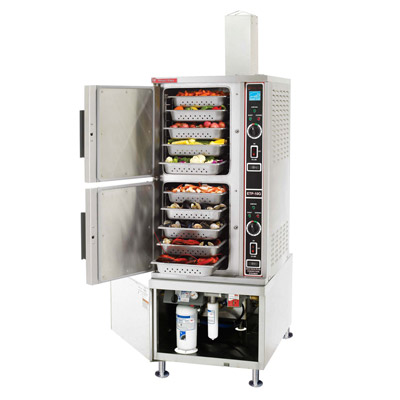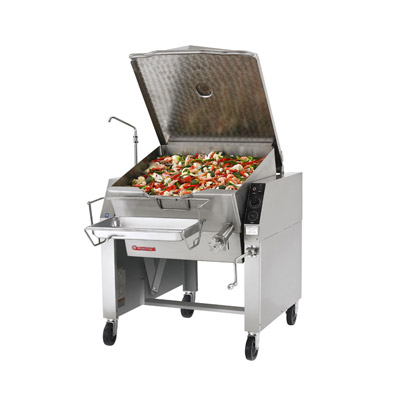Get more versatility from your kitchen equipment with Crown Steam
Over the years, The Middleby Corporation has partnered with Crown Foodservice Equipment to produce steam vessels for the foodservice industry. Middleby, who owns big name food brands including Pitco, Southbend, and Doyon, recently acquired Crown. That means the commercial steam equipment customers loved under the Southbend, Blodgett, FireX and Market Forge names are going away and is now known as Crown Steam (except for a few unique Market Forge steam products).
What does this mean for you? Customers can now appreciate one common pricing structure for all Crown Steam equipment, as well as having more options for operators and chefs as Crown Steam expands its commercial steam vessel offerings. This addition to Middleby brands reinforces the dependability that its customers and partners have always known.
Crown now offers an expanded line of heavy-duty steam equipment including:
- Convection steamers with rapid recovery functionality
- Large-volume kettles and heavy-duty tilting skillets
- Steam jacketed kettles
- Medium-to-large volume tilting braising pans
Advantages of cooking with steam
Steaming is a moist heat cooking method. The transfer of heat takes place when the steam meets the food. Food generally retains much of its natural flavor and nutrients when cooking with steam. When cooking with dry heat, timing is the most important variable, so the product does not become too dried out or burn. Steam is more forgiving because items are cooked with moisture, which often leads to more product yield and flavor retention.
More benefits include:
- Steam maintains a consistent temperature (at zero pressure), which makes it a precise form of cooking.
- The heat transfer of steam cooks food faster than other conventional methods.
- When using steam, there is no preheat time and steamers can be shut off between uses.
- Steam cooking reduces labor because it is a more automatic way of cooking.
- With most pressureless models, steam allows for preparing several types of foods simultaneously without flavor transfer; i.e. cooking a cake with vegetables and not worrying about the cake tasting like broccoli.
FireXSM.jpg)
Steam Jacketed Kettles
Many foodservice operations have commercial heavy-duty kettles as their primary pieces of kitchen equipment. Available in stationary, tilting and countertop models and all stainless-steel construction, kettles are a great way to cook product in large-to-very-large batches within a shorter timeframe.
Steam jacketed kettles basically use a double boiler method to gently and thoroughly cook foods in large batches like stews, soups and stocks with faster cook times than a normal stock pot. Self-contained kettles product their own steam, which carries 6 times the energy of boiling water and transfers heat directly to the product on all sides of the pot.
They allow for the operator to exercise more control over cooking temperatures and are also generally safer, more energy efficient and easier to clean than traditional stock pots. Steam kettles receive their best use in k-12 schools, colleges and universities, healthcare facilities, casual restaurants and delicatessens.

Pressure and pressureless convection steamers:
The most important thing about cooking with convection steamers is that they do not burn or dry out food, so they are perfect for items like chicken, seafood and vegetables. Meats and vegetables get plumper and juicier when cooking with moisture, instead of the shrinkage that happens when cooking with dry heat. Convection steamers come in gas and electric models with direct steam and steam coil options.
More features include:
- Split water line
- Simple, manual controls
- Heavy-duty ‘slammable’ doors
- Stainless-steel body and cabinet
- Deliming port for easy descaling
What’s the difference between pressure and pressureless steamers?
Pressure steamers are essentially large chambers that have a door-lock function which keeps air from getting in or out of the cooking cavity, and as a result, steam and pressure build up in the cavity and make the temperature inside rise above its normal boiling point(212°F at sea level). Built for batch cooking, these steamers yield very large quantities of cooked food and are best for large institutions like colleges, universities, correctional facilities and hospitals.
Pressureless steamers are not as quick to cook food because they don’t get as hot as pressureless steamers. However, one of the biggest advantages of cooking with a pressureless convection steamer is that when cooking vegetables, you don’t lose vitamins and minerals as you would with traditional boiling or roasting. Not only do vegetables keep the fiber and nutrients needed to sustain a healthy diet, they also retain their vibrant colors, which make them even more attractive to eat.
Pressureless steamers also give banquet prep-cooks the option to quickly heat large quantities of food in multiple pans in a single batch, producing large volume in a smaller amount of time. A greater variety of food can be prepared, as different food types can be cooked at the same time in most pressureless models. These convection steamers come in countertop models that take up a fraction of the space than other steamers, so you get a lot of use out of them with a smaller footprint in your kitchen. They are a staple in most general restaurants and seafood houses.
A pressureless steamer uses steam at normal atmospheric pressure to cook food at a constant temperature, which is about 212°F near sea level. However, this temperature drops as altitude increases, so steamers operating at high altitudes have longer cooking times due to lower steam temperature.

Tilting braising pans
If a chef was asked which piece of cooking equipment he or she would choose if they could only have one at their disposal, many would agree that it would be a skillet or braising pan because they are so versatile. Tilting braising pans heat from the bottom so foods can be browned in them. So, instead of browning meat for a stew in a sauté pan and then transferring to a large stock pot, one can simply brown any meat type in the braising pan and add the rest of the ingredients and liquids after, cover with a lid and bring to simmer or boil – all in one place, in large batches.
Crown tilting braising pans yield anywhere from 16 gallons to 80 gallons depending on the size. The skillets will also fit full size sheet pans, and can be used as a steamer and oven, for batch cooking of a variety of items, if desired. The tilting function is perfect for easy pouring into serving vessels and cleaning.
Tilting braising pans are a seven-in-one cooking vessel:
- Griddle
- Kettle
- Oven roasting and baking
- Frying
- Steam cooking
- Braising
- Warming/Serving
Browse all Crown Steam equipment here.
If you need assistance finding the right commercial steam equipment for your foodservice operation, please give us a call at 404-752-6715 (ext. 2 for sales) or stop by our showroom in the Atlanta suburb of Norcross at 6286 Dawson Blvd NE.


